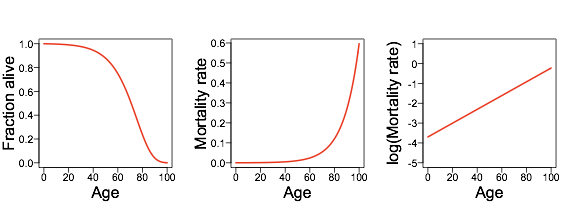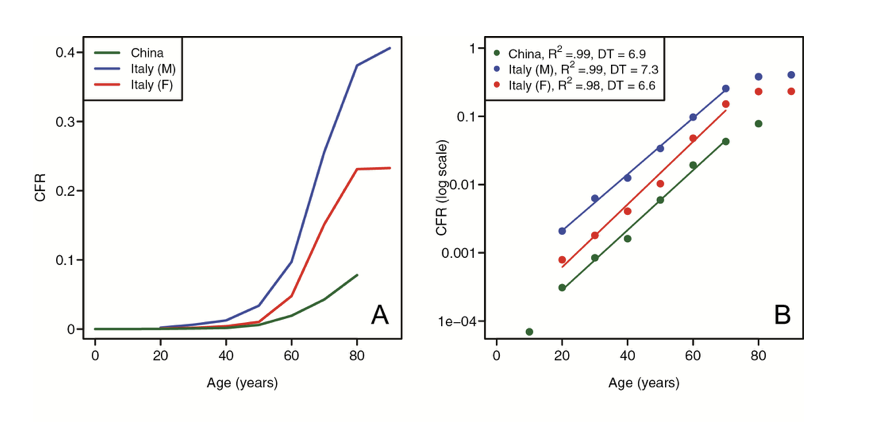Demography, the Gompertz Equation, and COVID-19
May 19, 2020 - 6 minutes readScientific discovery is often driven by the observation of patterns. Repeated phenomena usually have similar underlying causes. When we see the same things occurring again and again, we start asking questions and generating testable hypotheses to understand the patterns we see.
Demographers are researchers who study patterns of birth, reproduction, aging, and death. We measure birth rates and death rates, and often, we want to estimate the likelihood of specific life events at various ages. Demographers have long been aware of an important pattern in the relationship between age and mortality rate (risk of death).
For any given population, we classify individuals according to age class (for example, 0 – 10 years old, 11-20 years old, and so on), and for each age class, we estimate the mortality rate (typically, how many deaths per hundred thousand individuals). When we graph these data with age class on the x-axis and mortality rate on the y-axis, we see that the risk of death rises exponentially with age.
The general mathematical model that describes this pattern of age-specific mortality risk is called the Gompertz Equation where mortality rate (μ) at each age is described by an equation that includes a baseline component of mortality (a) and an age-related component of mortality (b). 
When plotted on a graph, the Gompertz Equation yields an exponential growth curve, often called the Gompertz Curve. When it is plotted on a logarithmic scale (instead of a typically 1-2-3 scale), the data is approximate a straight line, as shown in the figure below.
The Gompertz Equation describes age-related patterns of mortality for the vast majority of animal species, including dogs and humans. This pattern is even more apparent when the mortality rate due to specific diseases, such as cancer or heart disease, is plotted against age (because this removes accidental or non-natural causes of death).
For example, the figure below shows the age-related risk of mortality from multiple causes. Figure A shows deaths per 100,000 people on a regular scale, demonstrating exponential growth. Figure B shows the same data on a log scale, which makes it easier to compare the mortality rates attributed to different diseases. You might notice that on a log scale, we can visualize the elevated mortality rate for the very young, which you can’t see on the absolute scale.
 These figures are from our recent analysis of age-specific mortality due to COVID-19. This study, entitled “A Geroscience Perspective on COVID-19 Mortality,” will be published in The Journals of Gerontology: Series A.
These figures are from our recent analysis of age-specific mortality due to COVID-19. This study, entitled “A Geroscience Perspective on COVID-19 Mortality,” will be published in The Journals of Gerontology: Series A.
As geroscience experts, we have been closely following the demographic patterns of the current pandemic. It has become increasingly clear that this disease has much more devastating effects on the elderly than the young, and men are at greater risk than women. We wanted to quantify these emerging patterns. Using data from China, Italy, and the US, we demonstrated that the Gompertz Curve can be used to describe patterns of COVID-19 mortality and compared age-specific mortality rates for men and women.
The figure below depicts age-specific mortality rates for patients in China (men and women together) as well as age-specific mortality rates for men and women in Italy. As in the figure above, the left-hand panel is plotted on a regular scale and the right-hand panel is plotted on a log scale. By comparing the lines on the right, we see that the men in Italy have the highest risk of death at all ages, followed by women in Italy, and then by people in China.
What does it mean that COVID-19 mortality risk is influenced by age and sex? This is where the field of geroscience may have insight to offer. The process of aging includes declining function in many physiological systems and cellular processes such as immune and inflammatory responses. In addition, as we age, we are more likely to develop multiple diseases (called comorbidities) such as having heart disease and kidney disease–underlying conditions that seem to increase the risk of death from COVID-19.
The geroscience concept holds that treatments that target the underlying molecular pathways of aging biology, which are what shape this physiological decline, could, in turn, decrease risk for many different age-related diseases and improve outcomes in those with the disease. Some on our team have suggested that treatments that mitigate aging-related declines might thus have the potential to treat COVID-19. However, research is still needed to test this hypothesis.
At the Dog Aging Project, we’re committed to conducting rigorous science into the factors that contribute to healthy aging, and we’ve always believed that this research will inform human health. Our research team will continue to find ways to contribute to the world’s understanding of COVID-19. We are all in this together!

Daniel Promislow
Principal Investigator

